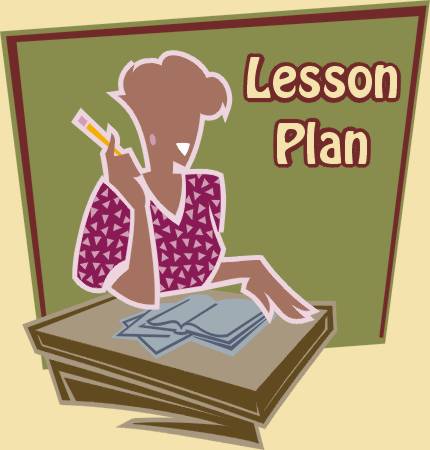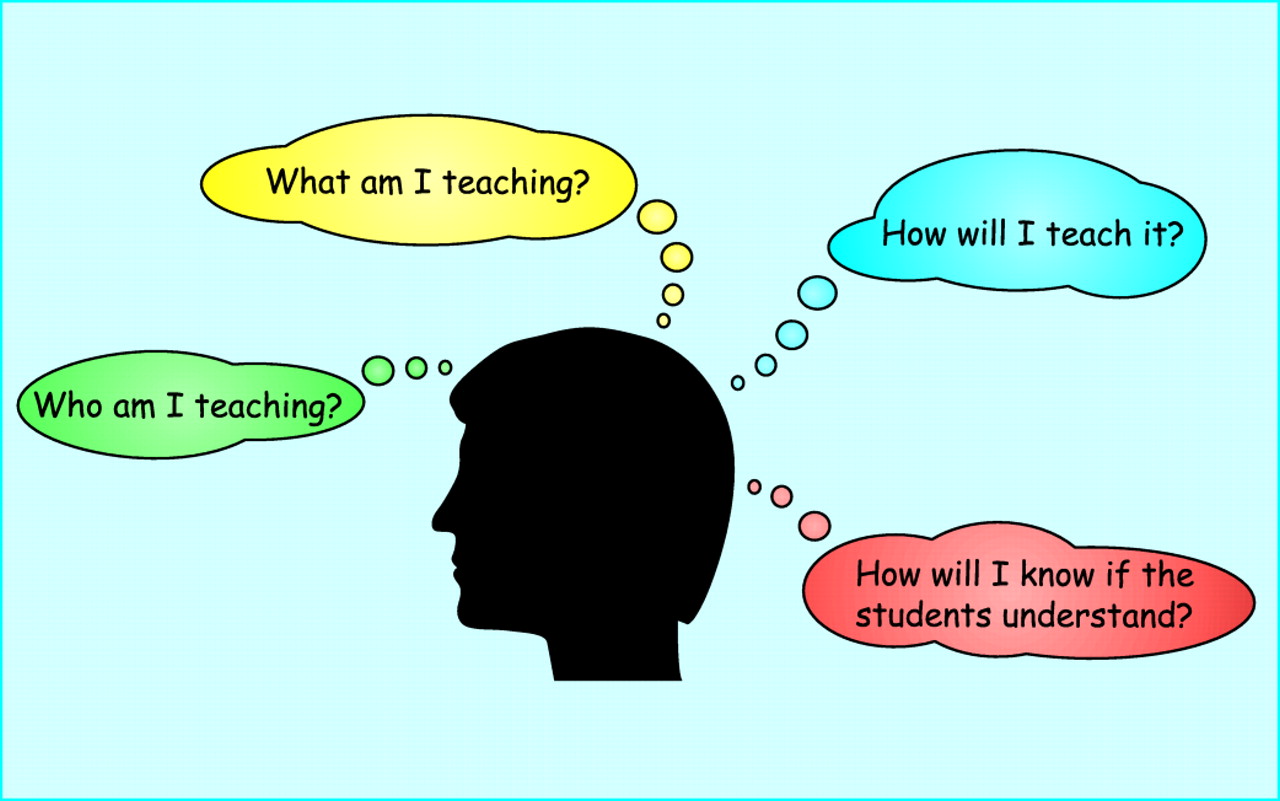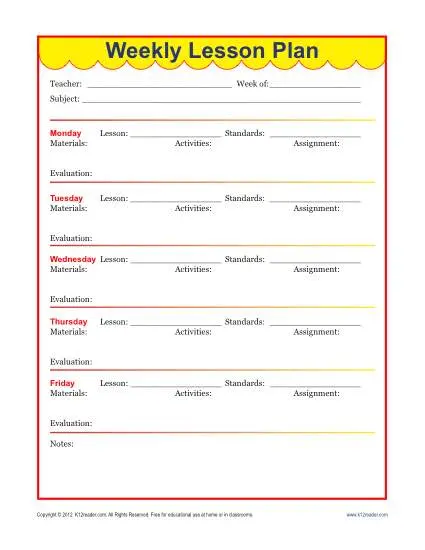As every single student learns differently,
teachers must look for the best ways to plan their classes, and take into
account all these differences so that all students benefit and learn.
Lesson plans are an essential component of a
successful teaching experience. These plans help ensure that all standards and
materials are covered, providing a teacher and students with structure for each
class day. Many schools require that teachers submit lesson plans in a specific
format on a daily, weekly or monthly basis. For teachers who do not have a
required format, there is a variety to choose from.
A five-step lesson plan is a form of
daily lesson planning that includes the following components: anticipatory set,
instruction, guided practice, closure or assessment and independent practice.
In the anticipatory set, a teacher
should list the objective of the lesson, explain how it connects to past
learning and describe the purpose for what is being learned. For the
instruction section, a teacher must list how she will use direct teaching
through modes such as lecturing, providing notes or showing a video, and
modeling by demonstrating how to complete a process or activity. The third step
is guided practice which asks the teacher to list any activity students will
complete in the classroom with teacher or peer assistance. This is followed by
the fourth step, closure or assessment, which requires an activity to help the
teacher get a snapshot of what students learned that day. Independent practice
is the fifth section of this format. In many cases independent practice can be
completed in class; however, in the five-steps plan, independent practice is
the place the teacher lists any homework assignments students will be expected
to complete related to that day's lesson.
Five-E Lesson
Plan
The five-E lesson plan format asks teachers to list components that deal with engaging, explaining, exploring, elaborating and evaluating. This lesson plan begins with a
question or brief activity that hooks or engages students at the beginning of
the lesson. In the second phase, the teacher lectures or provides a video,
reading passage or demonstration to explain the material and its key terms.
After explaining the concept, a
teacher must show what activity students will complete to help them explore the
material. These activities can include stations, cooperative learning groups,
games, worksheets or other instructional methods.
The fourth component, elaborate, can
be compared to independent practice. Activities should help students apply the
concept to a variety of situations. This work can be completed in class or as a
homework assignment.
Each five-E lesson plan ends with
an evaluation component to determine whether students have learned the
material. This can come in the form of a formal, graded assessment, or students
can be informally assessed with a question and answer session, exit slip or
short writing prompt.
Weekly
Lesson Plan
A weekly lesson plan is an ideal
format for teachers who are covering a similar topic throughout the week. At
the top of the lesson plan, teachers should list the standards, objectives and
essential questions being covered that week. Under that section, each day of
the week is listed with a short description of the activities for that day. At
the end of the plan, a section should be included to list any assessments that
will cover the week's instruction, such as a unit or chapter exam or special
project.
Unit Plan
 For teachers who do not work well
with elaborate plans, a unit plan is a simple way to guide instruction. At the
top of the unit plan, teachers list all of the standards and objectives covered
in the unit along with the projected time-frame for the unit. Below that is a
list of all activities expected to be part of the unit, followed by a list of
all assessments related to the unit. Each day, a teacher presents lessons to
students with that unit in mind, but since there is no specific plan laid out,
there is some flexibility in what is covered each day.
For teachers who do not work well
with elaborate plans, a unit plan is a simple way to guide instruction. At the
top of the unit plan, teachers list all of the standards and objectives covered
in the unit along with the projected time-frame for the unit. Below that is a
list of all activities expected to be part of the unit, followed by a list of
all assessments related to the unit. Each day, a teacher presents lessons to
students with that unit in mind, but since there is no specific plan laid out,
there is some flexibility in what is covered each day.
 For teachers who do not work well
with elaborate plans, a unit plan is a simple way to guide instruction. At the
top of the unit plan, teachers list all of the standards and objectives covered
in the unit along with the projected time-frame for the unit. Below that is a
list of all activities expected to be part of the unit, followed by a list of
all assessments related to the unit. Each day, a teacher presents lessons to
students with that unit in mind, but since there is no specific plan laid out,
there is some flexibility in what is covered each day.
For teachers who do not work well
with elaborate plans, a unit plan is a simple way to guide instruction. At the
top of the unit plan, teachers list all of the standards and objectives covered
in the unit along with the projected time-frame for the unit. Below that is a
list of all activities expected to be part of the unit, followed by a list of
all assessments related to the unit. Each day, a teacher presents lessons to
students with that unit in mind, but since there is no specific plan laid out,
there is some flexibility in what is covered each day.
Inquiry-Based Lesson Plan
 Inquiry-based lesson plans are
especially useful for the science classroom because they involve
experimentation and hands-on activities that allow the teacher to be a facilitator
of learning rather than an instructor. Lesson plans that are inquiry-based
include very little lecture or notes. Teachers begin this type of lesson plan
by listing the standards and objectives to be covered. After that should be a
detailed description of any activities students are to complete during the
day's lesson. Activities should not include worksheets or exams, but instead
includes hands-on, problem-solving experiences through experiments, cooperative
learning groups or stations. After the activity, teachers should list a variety
of inquiry-based questions to ask students to promote discussion of the
concepts and material covered in the activity and help further facilitate
student learning.
Inquiry-based lesson plans are
especially useful for the science classroom because they involve
experimentation and hands-on activities that allow the teacher to be a facilitator
of learning rather than an instructor. Lesson plans that are inquiry-based
include very little lecture or notes. Teachers begin this type of lesson plan
by listing the standards and objectives to be covered. After that should be a
detailed description of any activities students are to complete during the
day's lesson. Activities should not include worksheets or exams, but instead
includes hands-on, problem-solving experiences through experiments, cooperative
learning groups or stations. After the activity, teachers should list a variety
of inquiry-based questions to ask students to promote discussion of the
concepts and material covered in the activity and help further facilitate
student learning.



















